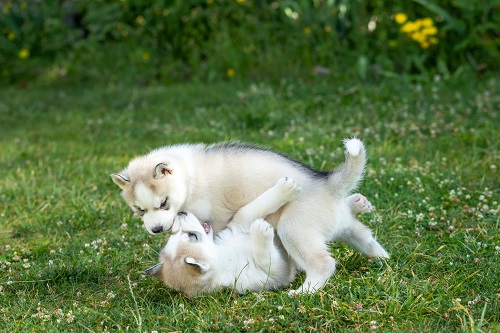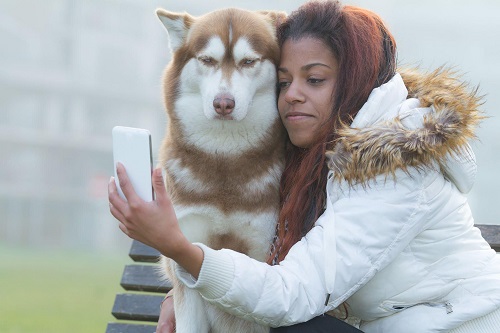Siberian Huskies, with their striking appearance and captivating blue eyes, have earned a special place in the hearts of dog lovers. Yet, behind their charming exterior lies a world of interesting behaviors that deserve exploration.
Studying into the unique behaviors of Siberian Huskies, we can forge a deeper connection with our four-legged companions and create a harmonious living environment for both pet and owner.
Some Siberian Husky Behavior Facts
Here are some unique facts about Siberian Husky behavior that showcase their incredible nature:
1. Born Adventurers:
Siberian Huskies have natural wanderlust. Their ancestors were bred to be sled dogs, traversing vast snowy landscapes. This wanderlust can lead them to explore new territories if not properly supervised.
2. Friendly Chatterboxes:
These talkative furballs have an unusual vocal range that sets them apart. Huskies engage in a variety of vocalizations, from expressive howls that mimic wolves to delightful “woo-woo” sounds when they’re excited or trying to communicate with their owners.
3. Social Butterflies:
Siberian Huskies possess an incredibly social nature. They love being around people and other dogs. Their friendly disposition makes them poor guard dogs, as they’re more likely to welcome a stranger with a wagging tail than a defensive stance.
4. Escape Artists:
Huskies are known for their cunning escape tactics. They can be remarkably resourceful when finding a way out of a confined space. Owners often need to be one step ahead in securing their environment to prevent Houdini-like escapes.
5. Cold Weather Enthusiasts:
Their thick double coat speaks to their cold-weather heritage. This insulation allows them to thrive in frigid conditions, but they might not do as well in hot climates. You might find them happily rolling around in the snow during winter!
6. Pack Mentality:
Huskies have a strong pack mentality due to their history of working closely with other dogs in sled teams. This can make them incredibly loyal to their human families, but it also means they might develop separation anxiety if left alone for extended periods.
7. Inquisitive Nature:
These dogs have an innate curiosity that drives them to investigate their surroundings. This curiosity can sometimes get them into trouble as they venture into places they shouldn’t. Husky-proofing your living space is a must!
8. Athletic Agility:
Huskies are exceptional athletes and agility-oriented. They are known for their ability to jump over high fences and dig under barriers, making them quite the challenge for owners who are caught off guard.

The Energetic Nature of Siberian Huskies
Siberian Huskies are renowned for their boundless energy levels. Bred for endurance and strength, these dogs were originally used as sled dogs in Siberia. Consequently, their genetic makeup predisposes them to thrive in environments where physical activity is necessary.
Maintaining an active lifestyle is crucial for a healthy Husky. A lack of physical and mental stimulation can lead to boredom, which may manifest as destructive behavior or excessive howling.
To channel their energy positively, engaging in daily exercises such as brisk walks, jogs, and interactive play sessions can reduce restlessness and fostering a well-behaved pet.
Social Creatures: Huskies and Their Pack Mentality
In their ancestral context, Siberian Huskies operated as integral members of sled dog teams, relying on their pack for survival and efficient work. This historical background has ingrained in them a strong sense of social camaraderie and companionship.
Modern-day Huskies rely on social interaction. They relish the company of humans and other dogs alike. Isolation can lead to feelings of loneliness and anxiety, potentially triggering undesirable behaviors.
As responsible owners, it is incumbent upon us to provide ample opportunities for socialization, ensuring our Huskies remain emotionally balanced and socially adept.
Communication Through Howling and Body Language
Siberian Huskies possess a distinct communication style that sets them apart from other breeds: howling. Howling is a genetic expression. It serves as a means of conveying emotions, seeking attention, and even announcing their presence.
Additionally, Huskies communicate through intricate body language. Tail positions, ear movements, and posture offer valuable insights into their feelings.
Recognizing these cues can help us decipher their moods and respond appropriately, fostering a stronger understanding between pet and owner.
Independent Thinkers: Stubborn yet Smart
Behind those bright eyes lies an intelligence that delights and challenges their owners. Siberian Huskies possess an innate cleverness that enables them to learn quickly, but their independent nature can also make them seem stubborn at times.
Training a Husky requires patience, consistency, and positive reinforcement. Traditional training methods may prove ineffective, as dogs tend to respond better to engaging, reward-based techniques.
By adapting our training approach to their unique mindset, we can unlock their full potential and cultivate a well-mannered companion.
Cold-Weather Champions: Adaptations to Harsh Climates
One of the most remarkable features of Siberian Huskies is their ability to thrive in cold climates. Their distinctive double coat protects against freezing temperatures, reflecting their evolutionary adaptation to Siberia’s unforgiving weather.
However, this adaptability also means Huskies may exhibit distinct behaviors in different seasons. During the warmer months, they may shed excessively as their bodies adjust to changing temperatures.
Being attuned to these seasonal variations equips us to provide the necessary care and grooming to keep their coats healthy year-round.
Curious Wanderers: Dealing with Roaming Tendencies
Siberian Huskies harbor an inherent curiosity and adventurous spirit, which translates into a penchant for wandering. This behavior harks back to their days as explorers and sled dogs, where roaming was essential to their survival.
Addressing this tendency requires training, secure fencing, and responsible supervision. By fulfilling their curiosity through engaging activities and providing a safe environment, we can strike a balance between their exploratory nature and safety.
Huskies and Children: Playful Companions or Potential Issues?
The interaction between Siberian Huskies and children can be a source of joy, but it also warrants careful consideration. Huskies’ exuberance and energy levels can be a perfect match for playful kids, yet proper supervision is essential to ensure a harmonious relationship.
Educating children about respectful behavior around dogs and teaching Huskies appropriate manners can foster a positive bond. Remember, a well-socialized Husky can become an invaluable playmate and guardian for your little ones.
Separation Anxiety: When Your Husky Misses You
The strong bond between Huskies and their owners can sometimes lead to separation anxiety. These dogs thrive on companionship, and extended periods of isolation can trigger feelings of distress and anxiety.
Combatting separation anxiety involves gradual training, desensitization, and establishing a sense of security. Providing comforting toys, creating a safe den-like space, and gradually increasing the time spent apart can help alleviate their emotional turmoil.
Prey Drive and Small Animals
Siberian Huskies possess a natural prey drive, which can pose challenges when cohabitating with smaller pets. Their ancestral instincts may drive them to chase or even harm smaller animals, such as cats or rabbits.
Early socialization and consistent training are pivotal in managing this instinct. Introducing them to smaller animals in controlled environments and reinforcing positive behavior can help mitigate potential conflicts and create a harmonious multi-pet household.
Grooming Rituals: Maintaining that Beautiful Coat
Huskies’ iconic double coat requires regular grooming to keep it in pristine condition. Brushing not only prevents tangles and matting but also helps distribute natural oils, ensuring healthy skin and fur.
Seasonal shedding is a hallmark of Husky ownership. Regular brushing during shedding seasons can help manage fur accumulation in your home and keep your Husky comfortable. Embracing this grooming ritual strengthens the bond between you and your pet, making it a mutually enjoyable activity.
Huskies and Other Pets: Navigating Multi-Pet Households
Introducing a Siberian Husky to an existing pet or a new addition requires careful planning and consideration. Proper introductions, gradual acclimatization, and supervised interactions are essential to promoting positive relationships between animals.
With patience and guidance, Huskies can coexist harmoniously with other pets. The key lies in understanding their dynamics, addressing any territorial tendencies, and ensuring each animal’s individual needs are met.
Health Matters: Behavioral Changes and Indications
Behavioral changes in Siberian Huskies can sometimes be indicative of underlying health issues. Sudden shifts in demeanor, appetite, or energy levels may warrant a closer look to rule out potential medical concerns.
Consulting a veterinarian when behavioral changes arise can provide timely insights into your Husky’s well-being. Early detection and intervention can ensure their physical health, as well as their emotional balance.

Positive Reinforcement: Training with Love
When it comes to training Siberian Huskies, positive reinforcement reigns supreme. These intelligent dogs respond best to rewards, praise, and engaging activities. Utilizing treats, toys, and affectionate gestures can create a conducive learning environment.
Building a strong, trusting relationship through positive reinforcement fosters cooperation and understanding. As a result, your Husky will be more receptive to commands and eager to showcase their newfound skills.
Conclusion
Understanding the behavior of your Siberian Husky is paramount to nurturing a happy and well-adjusted companion. From their energetic tendencies to their unique communication methods, each element of their behavior adds to their personality.
By acknowledging their heritage, adapting your approach, and providing the right care, you can embark on a rewarding journey with your Husky that’s filled with mutual love and respect.
